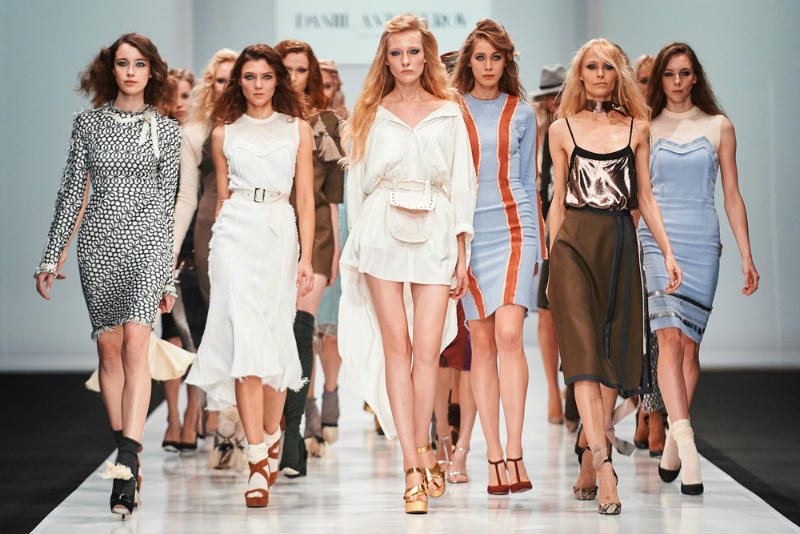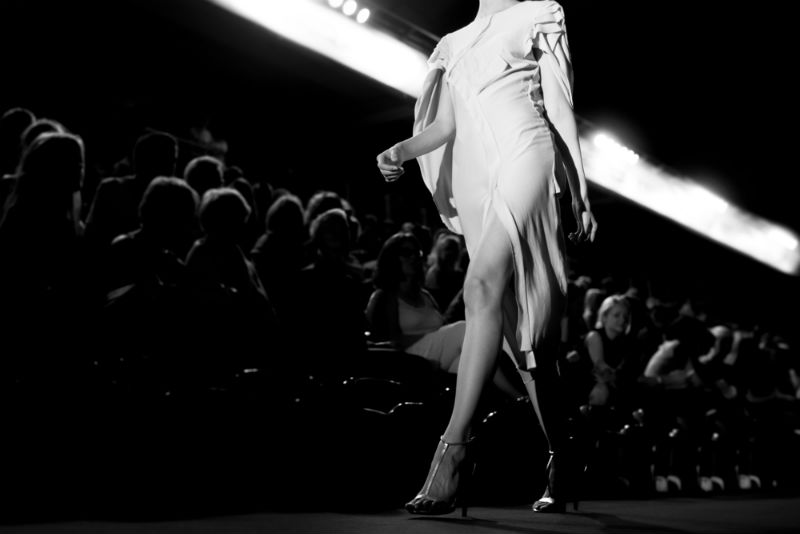In this guest edition of The Interview, James Blake Wiener talks to author Randy Bryan Bigham.
In the late 19th and early 20th century, one woman broke multiple social barriers to become the leading designer of haute couture: Lucy Duff Gordon (1863-1935). While her name is virtually unknown today, Duff Gordon’s was the first international couture brand, and she was responsible for many innovations in the fashion world that are still recognizable in 2016: the fashion catwalk, low and revealing necklines, and playfully sexy lingerie.
In this guest edition of The Interview, James Blake Wiener speaks to Randy Bryan Bigham, author of Lucile, Her Life by Design: Sex, Style and the Fusion of Theatre and Couture, about the life and legacy of history’s forgotten pioneer in fashion.
James Blake Wiener: Why isn’t Lady Duff Gordon better known aside from her survival of the Titanic disaster in 1912?
Randy Bryan Bigham: Because the Titanic is such a tangible subject, I guess. Anything and everyone connected with it is somehow more appealing. Don’t get me wrong—I’m interested in the Titanic, and it sparked my own fascination with Lucile and the history of that era.
Her impact on culture and fashion was very crucial, however, and not just as a woman who ran a global, million-dollar business. Lucile actually redefined the fashion industry through some extraordinary presentation and marketing feats—like the runway or catwalk show—and by extending the appeal of her exclusive couture brand to prêt-à-porter merchandising and endorsement deals. Luxury labels now are almost entirely sustained by mass-market diffusion lines of clothing, perfume and accessories, as well as through the commercial licensing of various “lifestyle” products. Lucile was doing that before anybody else.
Lucile was the designer most responsible for legitimizing the expression of sexuality in sheer lingerie and through other items of intimate, see-through apparel. Filmy tea-gowns are a case in point: They were made to be worn without corsets, making men’s tea-time seduction of their mistresses a lot more convenient. That’s where Lucile’s naughty reputation came in. We’ve all heard the saying “love in the afternoon.” Well, in Edwardian England, Lucile tea-gowns played an elegant role in facilitating that!
Wiener: In learning more about Lucile’s life, one cannot help but be impressed by her recognition of the importance of public relations. A master of self-promotion, she was a businesswoman during a time in which many women didn’t have a bank account in their own name. What was her recipe for success in the organization and presentation of her designs?
Bigham: I’d say Lucile’s instinct for publicity stemmed from her high-energy personality, and her understanding of how to present or “package” herself as well as her fashion house. Her whole business was an expression of her personality. Being a lady of title, she knew how the upper crust lived and behaved, so her magnificent salons in London, Paris and New York replicated the manor houses her clients were equally familiar with. Her love of dancing and of performing in society tableaux taught her gracefulness, which she imparted to the statuesque models she trained to display her gowns.
Although related to nobility (the Duke of Sutherland was a cousin), Lucile had a middle-class background. She was raised on a Canadian farm and was a contented tomboy until around the age of 10 when she bloomed into a girly-girl, sewing dresses for her collection of dolls. In the Titanic films that have cameoed Lucile, she’s often portrayed as a snob. It’s true she could be haughty and temperamental, but she was also a charmer. She was a flirt, loved to chit chat and enjoyed teasing people. Friends and family members recalled her wit and outspokenness, and the media stressed this, too, in the colorful interviews she used to grant reporters over tea or lunch.
 Her own clothes were dashing, and what she wore to this party or that were commented on in the daily papers. Lucile was petite, with a pale complexion, and had red hair. She was considered a beautiful woman in her day, and she played up her flamboyance by wearing Russian boots, carrying a tall Bo-Peep walking stick and choosing hats with streaming veils that made her look like she was on safari. Her sense of the dramatic may also have come from her childhood adoration of the glamorous Lillie Langtry whom she later befriended and dressed on stage and off.
Her own clothes were dashing, and what she wore to this party or that were commented on in the daily papers. Lucile was petite, with a pale complexion, and had red hair. She was considered a beautiful woman in her day, and she played up her flamboyance by wearing Russian boots, carrying a tall Bo-Peep walking stick and choosing hats with streaming veils that made her look like she was on safari. Her sense of the dramatic may also have come from her childhood adoration of the glamorous Lillie Langtry whom she later befriended and dressed on stage and off.
Wiener: Would it be fair to say that Lucile was the first fashion media celebrity in her own right?
Bigham: Probably. Lucile was certainly the designer with the highest profile in the United States, where she spent a number of years building up her New York branch. In America during World War I, she was constantly in the public eye, throwing charity balls and dressing Broadway extravaganzas like the Ziegfeld Follies. She also wrote a weekly dress advice column for the Hearst newspapers and a monthly one for Harper’s Bazaar. And she made a huge mark on the early film industry, styling silent stars Mary Pickford and Pearl White, among others. Lucile even appeared in her own fashion newsreel and toured vaudeville with a benefit style show, accompanied by her regal Chow.
In London, where the court dressmaking community was comparatively discreet, there was no one to rival Lucile as a couturier-personality. But her celebrity may have hurt her in England. For instance, it likely prevented her from being appointed dressmaker to Queen Mary. As princess of Wales, the queen had frequently bought frocks from Lucile, but she chose the more conservative Reville and Rossiter as her official couturier when she came to the throne in 1911. But I’ve found that Queen Mary still occasionally ordered gowns from Lucile, and at least once dropped by the shop in disguise.
Only in Paris were there other top designers who were also media personalities. Certainly Paul Poiret was a tremendous rival there, as were, to a slightly lesser extent, Jeanne Paquin and Louise Chéruit. Yet none of these designers maintained the same forceful presence in London or New York as they did in Paris, whereas Lucile regularly traveled between her international salons and participated in the social round in each of those cities. Most of the leading Paris designers never visited England or America.
Wiener: What was it about Lucile that attracted such a diverse group to her atelier and mannequin parades? Was it her unusual background and innate talent as designer and woman? She seems to have cast a veritable spell wherever she went.
Bigham: It was her vivacity and a refreshing directness that endeared her, especially to the racy bohemian set she was a part of. Lucile knew all the fashionables in London because they were her clients, but she didn’t usually socialize with them. She thought the royals and other society types were bores—and some were cheap, expecting their dress bills to be reduced if she accepted invitations to their parties. But there were exceptions. She was close friends with the queen of Spain (the former English Princess Victoria Eugenie of Battenberg) and when she and King Alfonso visited London, they sometimes lodged with Lucile and Sir Cosmo at their home in Lennox Gardens, instead of staying at Buckingham Palace.
But Lucile mainly liked artists, musicians, actors, writers. A favorite was Isadora Duncan. Isadora once danced naked in the garden of Lucile’s villa at Versailles. Other good friends were Cecile Sorel of the Comedie Francaise and decorator Elsie de Wolfe. Lucile knew the painters Roger Fry and William Orpen, art critic Bernard Berenson, and she openly embraced the emerging gay community. Several of her assistant designers were gay—Edward Molyneux, Howard Greer—as was a hanger-on named Maury Paul, the later gossip writer “Cholly Knickerbocker.” Still, another gay protégé was actor Clifton Webb who, oddly enough, would later mention her in a scene in the 1953 film Titanic, in which he starred with Barbara Stanwyk.
Wiener: Fashions changed in the 1920s when flappers in North America and Europe saw the excess that characterized the Gilded Age as passé and lacking modern élan. Unwisely, Lucile ignored the revolutionary trends emanating from Paris, including the sleek designs and garçonne look of Gabrielle Chanel. Why was she so resistant to the changes in fashion attitudes during the Jazz Age?
Bigham: She resisted the boyish look because, to her mind, it had no subtlety or grace. But Lucile never strictly followed fashion. She adhered to the general line only, though she sometimes opposed the prevailing mode outright. Her own look was delicate and faery-like, using pastel colors, layered chiffon and ribbon trimming that set her apart from the brightly-hued eastern styles of Poiret and his imitators. That’s not to say she wasn’t inspired by Orientalism; every designer then was affected by it. But Lucile’s overall style was young and light, exuding a dainty sexuality, a sort of cross between ingénue and coquette.
Lanvin exploited a youthful mood, but her girlish gowns were never sexy. Lucile dresses, on the other hand, had a flirtatious, boudoir air—a fluffy, transparent skirt revealing legs to the calves, a slinky dress with a side slit, exposing an ankle as the wearer moved.
It wasn’t until the early 1920s, when simpler-cut clothes became more general, that Lucile’s ultra-femininity and the exotica of Poiret began to lose their appeal.
But Lucile didn’t disappear. An ill-advised merger with a wholesale house and a string of disagreements led to her withdrawal from the company in 1922. Yet there was still a market for her snaky tea-gowns and peekaboo undies, and over the next decade she was involved in a series of couture and retail enterprises in London and New York.
Wiener: It’s worth noting that Lucile’s younger sister, Elinor Glyn, lived a life full of creativity and excitement too. A novelist and scriptwriter, she exerted a profound influence on Hollywood filmmakers and budding stars like Rudolph Valentino, Gloria Swanson and Clara Bow. In the 1920s, Elinor’s career in Hollywood blossomed just as Lucile’s fortunes in the fashion world waned. Could you compare and contrast these two sisters, describing their rivalry?
Bigham: Lucile and Elinor never really got on, at least not during the years of their great successes. The notoriety they received created a gulf between them. They jockeyed for press attention and resented each other’s fame. There was a lot of fussing between them in private, and their competitiveness sometimes spilled over in public. The only known photo of them during their respective careers was taken on the terrace of the Ritz in Paris in 1921. It’s a group snapshot, and not surprisingly the women are posed at opposite ends—Lucile smiling at the camera, Elinor eyeing her sister.
Lucile’s influence on the film industry preceded Elinor’s. She was the designer of choice for Lillian Gish and Marion Davies, and her floaty dresses were really the first Hollywood look. She worked with all the big directors—Cecil B. de Mille, D.W. Griffith—supplying costumes for major films like The Perils of Pauline and Way Down East. All this, and Lucile never stepped foot in Hollywood! Moviemaking was centered on the East Coast until the late 1910s, but even then, stars like Mary Pickford or Norma Talmadge would travel by train from Los Angeles to New York to consult Lucile for their screen wardrobes.
Later, when Elinor went to Hollywood to write scripts for Paramount, Lucile was hardly withering away in London. She had her own natural color newsreel spot, wrote columns for The Daily Express, once hosted a charity show with Noel Coward and Ivor Novello, held modeling contests and gave lectures attended by hundreds at a time. At one department store appearance she made in 1924, Lucile was mobbed by women trying to get her autograph, and at a 1930 press conference, to discuss what the new skirt length was going to be, she jumped up on a table to model it herself. So she stayed extremely active into her 70s and kept an optimistic attitude until the end.
Wiener: In your own words, how should we characterize Lucile’s imprint on fashion and her role within fashion history? What is her enduring legacy?
Bigham: Lucile brought theatricality to the marketing of fashion—that’s her greatest legacy. The crazy catwalk spectacles of today grew out of the refined tea-time style shows she staged over 110 years ago in London’s Hanover Square, a place still associated with fashion through Vogue House, headquarters for British Vogue. And the beautiful models we take for granted today, stomping down runways all over the world? They owe their careers to Lucile, who trained the first professional “mannequins,” sending them parading around her salon, balancing books on their heads.
Lucile’s legacy is also felt in the sexuality inherent in modern fashion, whether through the lingerie line her great-great granddaughter Camilla Blois has revived, or in the slit skirts and chiffon gowns that seem a perennial statement of femininity and liberation.
The views expressed in this article are the author’s own and do not necessarily reflect Fair Observer’s editorial policy.
Photo Credit: Catwalk Photos / Dmitry Abaza / Shutterstock.com
 We bring you perspectives from around the world. Help us to inform and educate. Your donation is tax-deductible. Join over 400 people to become a donor or you could choose to be a sponsor.
We bring you perspectives from around the world. Help us to inform and educate. Your donation is tax-deductible. Join over 400 people to become a donor or you could choose to be a sponsor.
Support Fair Observer
We rely on your support for our independence, diversity and quality.
For more than 10 years, Fair Observer has been free, fair and independent. No billionaire owns us, no advertisers control us. We are a reader-supported nonprofit. Unlike many other publications, we keep our content free for readers regardless of where they live or whether they can afford to pay. We have no paywalls and no ads.
In the post-truth era of fake news, echo chambers and filter bubbles, we publish a plurality of perspectives from around the world. Anyone can publish with us, but everyone goes through a rigorous editorial process. So, you get fact-checked, well-reasoned content instead of noise.
We publish 2,500+ voices from 90+ countries. We also conduct education and training programs
on subjects ranging from digital media and journalism to writing and critical thinking. This
doesn’t come cheap. Servers, editors, trainers and web developers cost
money.
Please consider supporting us on a regular basis as a recurring donor or a
sustaining member.
Will you support FO’s journalism?
We rely on your support for our independence, diversity and quality.









